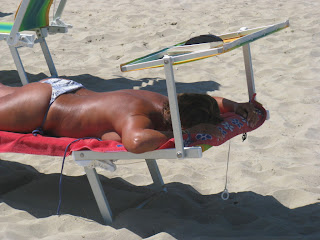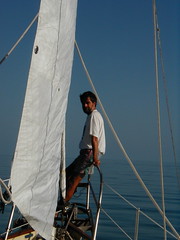Sienna has many attractions..the large Piazza del Campo where the horse Paleo is run every year is one, and the Duomo is the other. We honored both: on Piazza del Campo, we drank our most expensive italian cappucino gazing at the crowds and imagining the Palio...12 Euros for 2 cappucinis! During this event, the crowds must be amazing..we were there 10 days before and were surprised to see how full the city was! As excitement for the
Palio builds, it is customary for members of the various
contrade to dress in ceremonial garb and parade through the city in the historic centre.
Traditionally, its residents worked as potters;Nicchio's symbol is a crowned scallop shell flanked by two branches of coral. Its colours are blue, with yellow and red trim. Nicchio is one of only four nobile (noble) contrade; it earned its title for bravery shown during the Battle of Montaperti against Florence in 1260, when its soldiers led the attack. We also went for a stroll and a birra in the contrada of the goose! Oca is situated just to the west of the Piazza del Campo. Traditionally, its residents made dyes. Oca's symbol is a crowned goose wearing around its neck a blue ribbon marked with the cross of Savoy. Its colours are green and white, with red trim.
Oca is one of only four nobile (noble) contrade; it earned its title for its people's bravery during many battles fought by the former Sienese Republic.
The most recent palio win for Oca was in the July 2, 2007 race on Fedora Saura.
As time has gone by, however, the contrade have lost their administrative and military functions and have instead become simply areas of localised patriotism, held together by the emotions and sense of civic pride of the residents. Their roles have broadened so that every important event – baptisms, deaths, marriages, church holidays, victories at the Palio, even wine or food festivals – is celebrated only within one's own contrada.
Every contrada has its own museum, fountain and baptismal font, motto, allied contrada (only Oca has no allies) and adversary contrada, typically a neighbor (only four, Bruco, Drago, Giraffa and Selva, have no declared adversaries). Often the adversary contrade share borders.














































